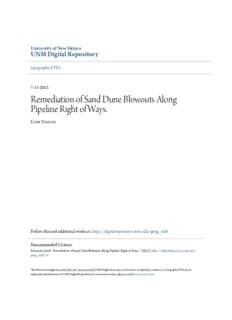
Remediation of Sand Dune Blowouts Along Pipeline Right of Ways. PDF
Preview Remediation of Sand Dune Blowouts Along Pipeline Right of Ways.
University of New Mexico UNM Digital Repository Geography ETDs Electronic Theses and Dissertations 7-11-2013 Remediation of Sand Dune Blowouts Along Pipeline Right of Ways. Knutt Peterson Follow this and additional works at:https://digitalrepository.unm.edu/geog_etds Recommended Citation Peterson, Knutt. "Remediation of Sand Dune Blowouts Along Pipeline Right of Ways.." (2013).https://digitalrepository.unm.edu/ geog_etds/16 This Thesis is brought to you for free and open access by the Electronic Theses and Dissertations at UNM Digital Repository. It has been accepted for inclusion in Geography ETDs by an authorized administrator of UNM Digital Repository. For more information, please [email protected]. Knutt Peterson Candidate Geography Department This thesis is approved, and it is acceptable in quality and form for publication: Approved by the Thesis Committee: Olen Paul Matthews , Chairperson Chris S. Duvall Bradley T. Cullen i REMEDIATION OF SAND DUNE BLOWOUTS ALONG PIPELINE RIGHT OF WAYS. BY KNUTT PETERSON BACHELOR OF SCIENCE GEOGRAPHY THESIS Submitted in Partial Fulfillment of the Requirements for the Degree of Master of Science Geography The University of New Mexico Albuquerque, New Mexico May, 2013 ii © Knutt Peterson, 2013 iii DEDICATION For my wife Leslie Rose, thank you for your love and support. I could not have achieved this goal without you. iv ACKNOWLEGMENTS I heartily acknowledge Dr. Olen Paul Matthews, my advisor and thesis chair, for encouraging me through the years of classroom teachings and the long number of years it took me to write these chapters. His guidance and professional style will remain with me as I continue my career. I also thank my committee members, Dr. Chris S. Duvall, and Dr. Bradley T Cullen, for their valuable recommendations pertaining to this study and assistance in my professional development. Gratitude is extended to the Bureau of Land Management, Roswell Field Office for the funding and time to pursue this research. A special thanks to Chuck Schmidt, Angel Mayes and Janell Desmond. To Jerry Williams, my first geography professor who inspired me to pursue geography as a profession, you made geography exciting! To my children Amber, Dillan, and Stuart, who gave me immeasurable support over the years. Your encouragement is greatly appreciated. And finally to my wife, Leslie Rose, your love is the greatest gift of all. v Remediation of Sand Dune Blowouts along Pipeline Right of Ways By Knutt Peterson B.S, Geography, University of New Mexico, 2006 M.S., Geography, University of New Mexico, 2013 ABSTRACT Blowouts in sand dunes along pipeline right of ways are a problem facing many pipeline maintenance companies, environmentalists, and public land managers. Blowouts form in sandy soils when the ground surface is not protected from seasonal winds. The ground surface becomes unprotected when there is a lack of vegetation covering the pipeline right of way. Most pipeline maintenance companies are using temporary mitigation methods. Results presented in this study demonstrate that there are low cost, long term solutions to the problem of blowouts along pipeline right of ways. Studies were conducted using three low cost mitigation methods. Branch piles showed that a successful depositional environment could be created at the same time protecting the surface from deflation. The net structures studied, were not as successful, but with further development could be a viable solution. Snow fence was studied in a closed cell configuration, with poor results. vi TABLE OF CONTENTS DEDICATION …………………………………………………………………………. v ACKNOWLEDGMENTS ……………………………………………………………... v ABSTRACT ……………………………………………………………………………. vi LIST OF FIGURES ……………………………………………………………………. x LIST OF TABLES …………………………………………………………….............. xi 1. INTRODUCTION …………………………………………………………………... 1 1.1 Background …………………………………………….…………………... 1 1.2 Problem Statement …………………………………………………………. 2 1.3 Objectives ...………………………………………………………………… 3 2. LITERATURE REVIEW ……………………………………………………...…… 8 2.1 Theory of Sand Movement ………………………………………………… 9 2.1.1 Wind Velocity and Sand Movement …………………………….. 9 2.1.2 Wind Direction and Blowouts ……………………………..…… 11 2.1.3 Surface Conditions ………………………….……………….….. 15 2.2 Methods to Mitigate Blowouts in Dune Field…………………………….. 17 2.2.1 Reducing Wind Velocity …………………………………..……. 18 2.2.1.1 Sand Fences …………………………………….……... 18 2.2.1.2 Netting …………………………………………….…… 20 2.2.1.3 Branches and Brush Piles …..…………………..……… 22 2.2.2 Surface Stabilization ………………………………………….… 22 2.2.2.1 Mulches and Chemical Sprays ………………….….... 23 vii 2.2.2.2 Vegetation and Grasses ………………….…………... 24 2.2.2.3 Geotextiles ……………………………………….……. 25 2.3 Summary …………………………………………………………….……. 28 3. METHODOLOGY …………………………………………………………….….. 33 3.1 Current Situation …………………………………………………….…… 33 3.2 Field Experiment …………………………………………………….…… 35 3.2.1 ROW Determination ……………………………………….…... 37 3.2.2 Test Site Determination …………………………………….….. 38 3.3 Experimental Plots …………………………………………………….…. 39 3.3.1 Plot Determination …………………………………..……….… 39 3.3.2 Plot Construction ………………………………….……….…… 40 3.3.3 Design and Construction of Sand Capturing Structures……... 42 3.3.3.1 Net Structure ………………………………………….. 43 3.3.3.2 Snow Fence Structure ………………………………… 46 3.3.3.3 Branch Structure ……………………………………... 48 3.3.4 Data Measurement Methodology ……………………………… 50 3.4 Data Logging ……………………………………………………………… 53 3.5 Data Processing …………………………………………………………… 54 3.5.1 Statistical Testing ………………………………………………. 54 4. RESULTS AND DISCUSSION …………………………………………………… 55 4.1 Accumulation Results ……………………………………………………. 55 4.1.1 Control Plots ……………………………………………………. 56 4.1.2 Fence Plots ………………………………………………………. 57 viii 4.1.3 Net Plots …………………………………………….………….… 57 4.1.4 Branch Plots ……………………………………….….………….. 59 4.2 Discussion of Experiments ………………………………….….………...... 59 4.3 How the experiments did …………………………………………….…….. 71 4.3.1 Successes ………………………………………………………… 72 4.3.2 Failures ……………………………………………….………….. 72 4.4 Implications for Applications on Pipelines ………………...………….…… 73 4.5 Future Studies …………………………………………………..………….. 75 5. CONCLUSIONS …………………………………………………………………… 77 5.1 Limitations and Recommendations ………………………...……………… 79 6. REFERENCES CITED ……………………………………………………………. 80 7. APPENDICES ……………………………………………………………...………. 85 APPENDIX 1 ………………………………………...………………….……..……… 85 Field Data Collection Sheet ……………………………………..……...……… 85 APPENDIX 2 ………………………………………………...……….…..…………… 86 Data Tables for Control Plots ………………………………...……...………… 86 Data Tables for Branch Plots ……………………………...…………………… 87 Data Tables for Fence Plots …………………………………...………..……… 88 Data Tables for Net Plots ……………………………………..……………….. 89 APPENDIX 3 …………………………………………………………………………. 90 Map of Test Site 1 ……………………………………………………..………. 90 Map of Test Site 2 ……………………………………………………..………. 91 Map of Test Site 3 ………………………………………………………..……. 92 ix
Description: